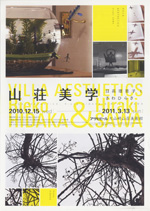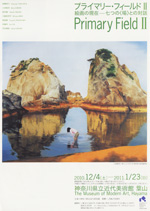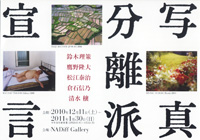 |
Picks is a monthly sampling of Japan's art scene, offering short reviews of exhibitions at museums and galleries in recent weeks, with an emphasis on contemporary art by young artists. |
 |
 |
 |
1 February 2011 |
 |
| 1 | 2 | |
 |
|
 |
 |
|
|
 |
 |
 |
 |
| Villa Aesthetics: Rieko Hidaka & Hiraki Sawa |
| 15 December 2010 - 13 March 2011 |
Asahi Beer Oyamazaki Villa Museum of Art
(Kyoto) |
 |
| This joint show is a surprisingly nice fit for a unique museum housed in a refurbished prewar villa outside of Kyoto. Hidaka introduces five large monochrome paintings of the branches of a sarusuberi (crape myrtle) tree, while Sawa offers eight video works that insert outlandish images into familiar environments. While Hidaka's exhibit fills the space-age annex designed by Tadao Ando, Sawa's -- including new work filmed in the museum -- is tucked away in odd corners of the main villa: in a drawer, next to a window, inside a café showcase. |
|
|
 |
|

|
 |
 |
|
|
|
|
|
 |
 |
 |
|
|
Primary Field II
|
|
4 December 2010 - 23 January 2011
|
The Museum of Modern Art, Hayama
(Kanagawa) |
 |
| The second in a series, this installment features seven artists who have been active since the 1990s (Primary Field I, which took place three years ago, focused on the eighties). Whereas the first show was heavy on solid objects, this one consists almost entirely of paintings and other two-dimensional works (if one includes reliefs and embroidery), and the images are mostly figurative. The artists are Nobuyuki Takahashi, Mana Konishi, Takeshi Hosaka, Mitsuko Miwa, Tsuyoshi Higashijima, Zon Ito, and Yasue Kodama. |
|
|
|
|
|
|
 |
 |
|
Masayuki Shioda: SFACE, DNA (Dirty Npeaker All)
|
|
11 December 2010 - 30 January 2011
|
G/P Gallery
(Tokyo) |
 |
| Photographer Shioda's first solo show in three years, this one amply testifies to his refusal to focus on one particular approach and his impulse to scatter various forms of noise throughout his work. Giant monochrome photocopy portraits, graffiti-like works that appear to be scrawled with a light pen, and a series of color prints left outside to collect dust prove that Shioda continues to do what he darn well pleases. |
|
 |
 |
 |
| Photography Secessionist Declaration |
| 11 December 2010 - 30 January 2011 |
NADiff Gallery
(Tokyo) |
 |
| This is the inaugural show by a group of five photographers and photography critics born in the same year, 1963: Risaku Suzuki, Ryudai Takano, Taiji Matsue, Shino Kuraishi and Minoru Shimizu. Their joint statement -- "Today, we ask anew: what is photography, and what are its possibilities?" -- sounds intrepid enough, but the works here are disappointingly small in size and few in number (granted, it's a tiny gallery). Their boldest stroke is displaying the galleys of their Declaration, covered with red-ink revisions by various members -- evidence of how difficult it is for a group like this to reach consensus. |
|
|
|
|
 |
|